|

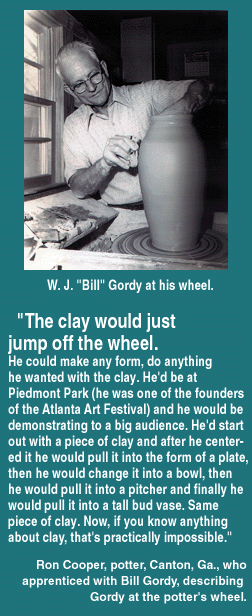 When word spread that Georgia potter, W. J. "Bill"
Gordy was emptying his kiln, collectors and fans got up at 4 o'clock in
the morning to be there. By the time Gordy arrived at his showroom a line
of cars stretched down the old Dixie Highway waiting for him. Within a few
minute he had sold every piece that came from the kiln. When word spread that Georgia potter, W. J. "Bill"
Gordy was emptying his kiln, collectors and fans got up at 4 o'clock in
the morning to be there. By the time Gordy arrived at his showroom a line
of cars stretched down the old Dixie Highway waiting for him. Within a few
minute he had sold every piece that came from the kiln. Such was the popularity of this talented artist,
whose works can be found displayed in the Smithsonian Institution in
Washington, in cherished collections, and in utilitarian use in homes in
the South. This is his biographical story as related by Potter Ron Cooper
of Canton, Ga., who began learning his skills at Gordy's wheel as a young
boy.
W. J. "Bill" Gordy was born on May 18,
1910, into a family of potters. His Scottish ancestors migrated South from
Maryland around 1790, into Hancock County, Georgia. His relatives include
the Bishop family of potters in the "Jugtown" area near Thomaston, Ga.
Bill's father resettled in Aragon, Ga., and continued making utilitarian
type pottery. Bill grew up around the pottery shop and by age 14 was
making pottery.
The clay came out of the flint River area
in Middle Ga. His father had a large wood kiln and Bill learned a lot
about burning from him. He also learned from the itinerant potters hired
by his father from around the country. He read every book he could find
about glazes and began early on experimenting. For instance, he observed
that lithium carbonate added to the Albany slip added a beautiful yellow
streak to the glaze. As a young man he left his father's shop and worked for several other
potteries in the Carolinas and Georgia, learning different techniques and
materials everywhere he went.
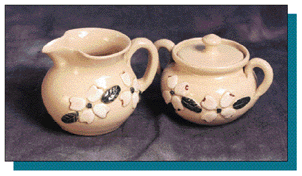 By 1935 Bill was
married and opened his own shop. He soon started developing his own clay and
glaze mixtures. His shop, right beside the old "Dixie" Highway (Highway 41) soon
became a favorite for tourists ("Snowbirds") traveling between Florida and
Michigan as well as other northern states. Gradually, the local residents
discovered him. For twenty years he sold everything he could make as it came
from the kiln. By 1935 Bill was
married and opened his own shop. He soon started developing his own clay and
glaze mixtures. His shop, right beside the old "Dixie" Highway (Highway 41) soon
became a favorite for tourists ("Snowbirds") traveling between Florida and
Michigan as well as other northern states. Gradually, the local residents
discovered him. For twenty years he sold everything he could make as it came
from the kiln.
Ron Cooper was one of more than twenty five people who worked for him
throughout the years. Of all those who worked there he is the only one who
picked up the trade and went on to make his living in the pottery business. He
started working for Mr. Gordy when he was thirteen. During school he worked
after school and on Saturdays. During the summer he worked six days a
week.
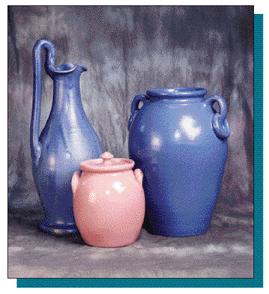 He remembers, "He
stopped using the wood kiln around 1955, about four years before I came to work
there. My dad and others would tell me about how a bunch of the old timers would
come and sit around and play setback and checkers while he burned the wood kiln.
They'd make sort of a community event out of it. He remembers, "He
stopped using the wood kiln around 1955, about four years before I came to work
there. My dad and others would tell me about how a bunch of the old timers would
come and sit around and play setback and checkers while he burned the wood kiln.
They'd make sort of a community event out of it.
"He used the gas kiln when I came along. He was very particular about
what he would allow me to do. He wouldn't let me load the wares in the kiln. It
was ok for me to unload and transfer the pottery to the display room and get it
ready to sell. When he loaded the kiln I would roll the little balls of chuck
clay that each piece would sit on and hand the pottery to him to
load."
Gordy observed the changing nature of the pottery business, having lived
through the depression, prohibition and the war years. The products changed with
the times, as people had less need for churns and jugs, for example, and more
need for less utilitarian type pottery.
When asked what made Bill Gordy such a great potter, Ron
Cooper replies, "For one thing, he cut his teeth in the business. That's all he
ever knew. He was dedicated to it. He was one of the most innovative potters of
his time. He came through a time when potters were quitting the business because
there was no longer a demand for what they were making. He knew there was a
market there and by changing over to artware he opened up a whole new market. It
required extensive transition from the type clay he had been using to the glazes
as well as the forms. He felt that by making a ware that was functional and that
would fit any decor he could maintain a good sales base. Not only was he a good
potter but a very wise business man as well."
Ron Cooper worked for Bill Gordy until he graduated from
high school and later opened his own shop. He and Bill Gordy remained close and
Gordy remembers him fondly in his book, Evolution of a Potter, Conversation With
Bill Gordy, by Lindsey King Laub c. 1992, The Bartow History Center. When asked
what he learned from working with Bill Gordy, Ron Cooper says, "To me, the best
way to learn is through close observation. I watched him intently and studied
his moves and then I would try to mimic him.
"When he would make a piece of pottery, his moves were so
fluid and natural that he made it look so simple. Then when I would try it, it
would seem like such a struggle and I would wonder why is this so easy for him
and so hard for me?"
Even after Bill Gordy had made a name
for himself as one of the world's finest potters, he still was reluctant to
raise his prices. He never desired to get into wholesaling either. Although
Rich's wanted to contract for his work, he felt this would compromise the
quality if he had to produce great volumes on their timetable.
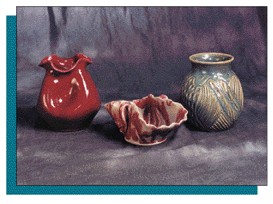 Ron Cooper tells a
story that demonstrates Mr. Gordy's humility. "He was selling half gallon
pitchers for twenty five dollars each and could have sold them for a hundred
dollars. People would have bought everyone he made. He was also selling half
gallon covered pitchers for twenty five dollars. One day I said to him, "Mr.
Gordy, you sell half gallon open pitchers for twenty five dollars and you sell
half gallon covered pitchers for the same price. It takes the same amount of
clay and effort to make a lid as it does to make an ashtray that you sell for
four dollars but yet you're giving the lid free." He said, 'Ronald, you know
what a loss leader is?' I said, 'Yes, you sell toothpaste two for a dollar to
get someone into your store hoping that while they are there they will buy other
items that you are making a profit on.' He said, 'That is exactly right that
half gallon covered pitcher is my loss leader.' Now imagine a man that was
already a legend, who had his work in the Smithsonian, that still thought that
way. Now that's humble. Ron Cooper tells a
story that demonstrates Mr. Gordy's humility. "He was selling half gallon
pitchers for twenty five dollars each and could have sold them for a hundred
dollars. People would have bought everyone he made. He was also selling half
gallon covered pitchers for twenty five dollars. One day I said to him, "Mr.
Gordy, you sell half gallon open pitchers for twenty five dollars and you sell
half gallon covered pitchers for the same price. It takes the same amount of
clay and effort to make a lid as it does to make an ashtray that you sell for
four dollars but yet you're giving the lid free." He said, 'Ronald, you know
what a loss leader is?' I said, 'Yes, you sell toothpaste two for a dollar to
get someone into your store hoping that while they are there they will buy other
items that you are making a profit on.' He said, 'That is exactly right that
half gallon covered pitcher is my loss leader.' Now imagine a man that was
already a legend, who had his work in the Smithsonian, that still thought that
way. Now that's humble.
"He had to be very competitive with his prices in the
beginning because people didn't have money to spend, but he had lived through
that. He was in a time when he could have doubled and tripled his prices easily.
I would have paid that for it and I think almost anybody would have. But his
idea was that he still needed to have a "loss leader" to draw
people."
Bill Gordy continued studying pottery, experimenting and
turning pots all his life. Although he had begun with "swamp clay" from the
Flint River area, he learned to develop his own blends. He used Georgia Kaolin,
Ohio stoneware, Ohio red clay and Kentucky ball clay. He experimented with
chrome, cobalt, tin and zirconium, silica, talc, feldspar, bentonite, copper,
lime and many other chemicals to produce different colors and textures. He even
experimented with the placement of various colors and various locations in the
kiln. The beautiful golden brown he referred to as Mountain Gold became his
trademark. He also produced stunning variations of blue, another favorite of
collectors. He also developed unusual shades of pink and turquoise.
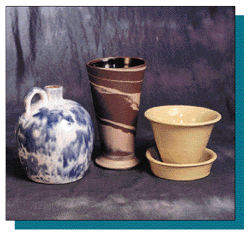 One brother, D.X.
Gordy, also showed an early interest in pottery and he too became a renowned
potter. D.X. was known more for his decorative and sculpturing ability. He could
take the simplest shapes and turn them into beautiful decorated forms. The two
brothers remained close throughout their lives. One brother, D.X.
Gordy, also showed an early interest in pottery and he too became a renowned
potter. D.X. was known more for his decorative and sculpturing ability. He could
take the simplest shapes and turn them into beautiful decorated forms. The two
brothers remained close throughout their lives.
Many Bill Gordy Pottery collectors remember fondly getting up at four
o'clock on the day he emptied his kiln. By the time Gordy arrived at his
showroom there was a long line of cars waiting for him. Within a few minutes he
had sold every piece that came from the kiln.
To behold the quality of W.J. "Bill" Gordy's Pottery is a rare pleasure;
but to know the quality of the potter behind the pot is to make the pleasure
more sublime.
1999
|